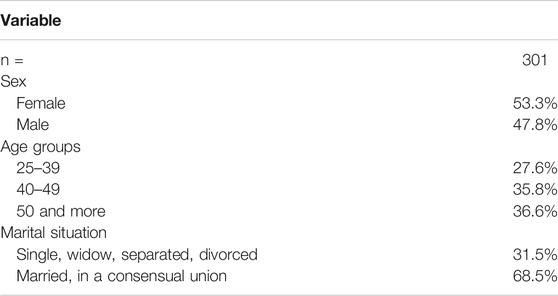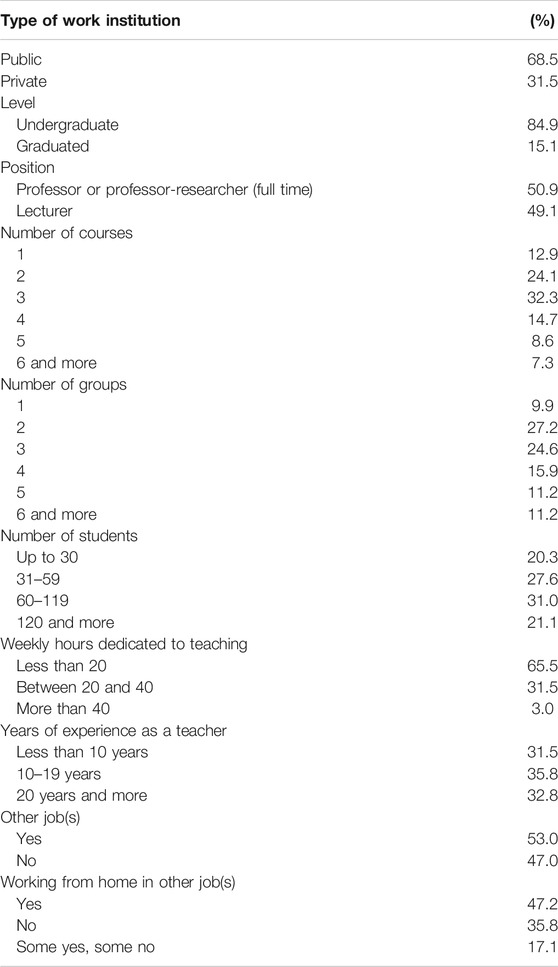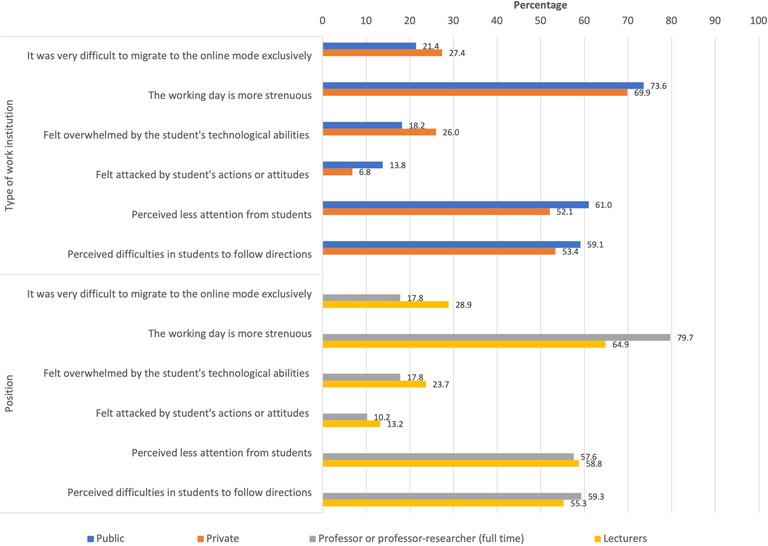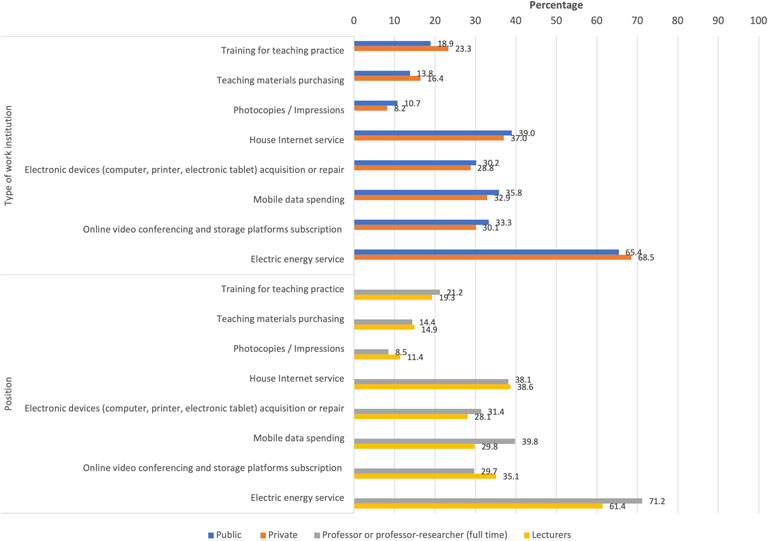Higher Education Teaching Practices Experience in Mexico, During the Emergency Remote Teaching Implementation due to COVID-19
- 1Healthy Border Program, US-Mexico Border Heath Commission, Tijuana, Mexico
- 2Escuela Internacional de Negocios, Universidad Anahuac, Cancun, Mexico
- 3Facultad de Contaduría y Administración, Universidad Autónoma de Baja California, Tijuana, Mexico
Higher education teaching practices experience in Mexico changed from face-to-face teaching to the emergency remote teaching derived from the health contingency by COVID-19. The change from face-to-face to an online modality in the Mexican education system represented a great challenge for teachers of all educational levels. In Mexico, the federal government declared on Tuesday March 24, 2020, Phase 2 of the plan to address the country’s Covid 19 pandemic. Governments in at least ten states decided to suspend their activities and services as of March 17, including the education system. On April 13, the Mexican education system began activities in the online modality exclusively; however, derived from the country’s technical adequacy and digital connectivity conditions, a large proportion of the educational campuses, academic programs, and the teaching staff were not prepared for this situation. This cross-sectional study was carried out to analyze the faculty members experiences about the change from face-to-face to an online modality in the health emergency context due to the COVID-19 outbreak. We designed a study to gather information on practice in the new online learning scenario. For this purpose, we collected data on the previous experience in the conduct of online courses, the technological tools used, the barriers faced while driving online courses, the current conditions of use of educational and technological tools, the vision for the future, and some indicators of physical and mental health.In a sample of 341 faculty members, those working in public institutions were on less favorable terms than their peers attached to private universities. In contrast, lecturers recorded better conditions for dealing with modality change than full-time teachers. Likewise, lecturers more often mentioned having their infrastructure to teach courses from their homes than full-time teachers, which indeed responds to less access to the universities facilities in which they teach. Another important aspect to highlight is the increased proportion of teachers in public institutions and lecturers who have other jobs, so their workload can be more intense than those of their peers.
Introduction
As in so many other countries, the change from face-to-face to distance-driven courses in Mexico represented a significant challenge for teachers of all educational levels. Most governments worldwide have closed education institutions as an attempt to contain the dispersion of COVID-19. The temporary closure affects approximately 23.4 million higher education students and 1.4 million teachers in Latin America and the Caribbean; this represents about more than 98% of the region’s population of students and higher education teachers (UNESCO, 2020a).
In Mexico, on October 2020, all schools are still closed by the health status declaration issued on March 14, 2020. Since then, 36 million students of all educational levels follow the process of distance learning (Fernández et al., 2020). The 2019–2020 school year has enrolled 4,931,200 undergraduate and graduate students; of these, 869,556 were already online students (Asociación Nacional de Universidades e Instituciones de Educación Superior – ANUIES, 2020). In Mexico, school cycles begin in August and end in June of the following calendar year. In this way, the health emergency was included in the second half of the 2019–2020 cycle.
In this article, we adopt the emergency remote teaching definition provided by Hodges et al. (2020), as a temporary switch from face-to-face teaching to an alternate instructional delivery mode derived of extraordinary events, which implies the use of remote teaching tools for education instead of teaching delivered in a classroom, and that will return to the face-to-face format once the emergency has been controlled. It is important to highlight that emergency remote teaching model implies a fast-track development, and is based in a temporary instructional support system as a result of a crisis, without pre-planned resources or infrastructure, as is required in online learning programs (Whittle et al., 2020). On the other hand, a fully online university course typically requires six to nine months to plan, prepare, and develop a course to be successfully taught (Hodges et al., 2020). In addition, emergency remote teaching implies the use of synchronous communication tools to develop a teaching session, as a replacement of classrooms sessions; online courses are usually developed in an asynchronous fashion.
The change from face-to-face to the emergency remote teaching in the Mexican education system, like that of so many other countries, represented a great challenge for teachers of all educational levels. In Mexico, in the 2018–2019 school year, 4,705,400 undergraduate and graduate students had been attended by 414,408 teachers in 5,535 schools (SEP, 2019).
In the Universities in Mexico, 71% of teachers have a lecturer category. Lecturers have as their primary employment an occupation related to a specific discipline, this promoting teaching by linking real practice and higher education. On the other hand, lecturers may be not integrated into the academic programs. They also had limited benefit from continuous training even if they teach 40 h of classes per week, in various faculties or programs of the same institution or several institutions (OECD, 2019).
Before the health emergency, virtual education was present in most of the largest higher education institutions, public or private, either as an extension of the physical classroom or as a virtual campus. However, this has depended on the capacities of the institutions themselves (UNESCO, 2020a).
In Mexico, remote education began with the need to promote literacy in rural populations, depending on the communication tools available in those times. In 1941 the Primary Radio School for Adults was created; in 1947 the Federal Institute of Training for the Magisterium was created; in 1968 the Center for Basic Adult education and tele-secondary was created; in 1971 the Center for the Study of Advanced Means and Procedures of Education was formed (Navarrete-Cazales and Manzanilla-Granados, 2017). These models have had a favorable impact as a training alternative for social groups that cannot be adapted to the traditional school education model (Moreno and Cardenas, 2012). These models consist of the transmission of content; by following a model of expository pedagogy with evaluations to give information on learning and accredit the degrees. The instructor has a transmission role. The student has to listen or read and follow guidelines, respond to exercises, and be evaluated. There was no synchronization in communication, and this communication is a one-way road.
The pioneers of distance university education in Mexico were the Universidad Nacional Autonoma de Mexico -UNAM- and the Instituto Politecnico Nacional -IPN-. In 1972, the UNAM created the Open University System, which is currently known as the Coordination of Open University, Educational Innovation, and Distance Education-CUAIEED- (UNAM, 2020), and IPN created the Open Teaching System in 1974 (Navarrete-Cazales and Manzanilla-Granados, 2017). In the past 25 years, university education online offerings has increased in public and private schools. In 1997 the Instituto Tecnológico y de Estudio Superiores de Monterrey -ITESM-founded the Virtual University (Moreno, 2015); the Universidad Virtual del Estado de Guanajuato started operations in 2007 (UVEG, 2020); and the Open and Remote Universidad de Mexico was created by presidential decree in 2012 (UnADM, 2020). Since 2009 it has operated as a program of the Ministry of Public Education (UNAM, 2020). Currently, virtual education is considered a means to improve university students’ skills and learning (Duran, 2015).
The change from face-to-face to the emergency remote teaching took place in a Mexican education system characterized by the lack of teachers trained to incorporate information technologies into the daily pedagogical experience, insufficient technological capacity to meet the simultaneous demand of millions of users, and unequal access to the availability and use of information technologies in Mexican households (Fernández et al., 2020).
In Mexico, 44.3% of the country’s households have a computer, and 56.4% have internet through a fixed or mobile connection. The service shows slow information transfer (50.1%) and constant interruptions (38.6%). In particular, 39.1% of students in the country lack this service (Instituto Nacional de Estadística y Geografía- INEGI, 2019). On the other hand, the availability of technology seems insufficient for the number of people who usually live on average households, which were 3.7 people in 2015 (Instituto Nacional de Estadística y Geografía- INEGI, 2015).
The confinement derived from the health contingency by COVID-19 brings significant challenges for teachers of all educational levels. It requires great adaptations and the development of new skills to comply with the curriculum. Moreover, insufficient technological endowment or trained personnel has also added the need to create or modify processes and the lack of adequate personnel to develop such processes and adaptation technologies. However, with no more time to prepare these conditions, teachers have been forced to work with creative and innovative solutions, over the march, adapting, and easing the content and designs of learning courses in different training areas. The intensive use of these platforms and tools in traditional courses always depends on the initiative of teachers (UNESCO, 2020a)
Gradually, teacher’s strategies to adapt to remote education derived from the health contingency have been published and are no longer just the anecdotes in social media. To date, UNAM published a study of Educational Challenges during the COVID-19 pandemic. As a result, they find that the main problems faced by teachers are related to logistics (43.3%), technology (39.7%), pedagogical challenges (35.2%), and socio-emotional status (14.9%) (Sánchez et al., 2020). Another study to identify teachers, students, and their families’ educational experiences in basic education, during COVID-19 confinement was conducted at the National level by the National Commission for the Continuous Improvement of Education. The results were pending as of this publication (Comisión Nacional para la Mejora Continua de la Educación -MEJOREDU, 2020).
Materials and Methods
This is a cross-sectional, exploratory, non-experimental, and descriptive study through an online questionnaire. The research question for this study is to understand the challenges faced by higher education instructors and students as a result of the implementation of the emergency remote teaching model in the context of COVID-19 outbreak, considering that there could be significative differences between public and private higher education institutions. In the instructor’s case, this study expected a significative difference regarding challenges faced between instructors accordingly to the type of contract they have with their employer (full-time professor and lecturer).
Sample
The sampling was carried out by the snowball technique to higher education teachers of Mexican public and private institutions. The decision of using snowball sampling for this study was based on the lack of access to a list of faculty members from diverse higher education institutions, which is a requirement for random sampling (Etikan et al., 2015). In addition to the lockdown restrictions imposed by health authorities to avoid mobility as a measure to slow COVID-19 spread, the possibility of getting access to instructors from several higher education institutions across the nation was another incentive to choosing this sampling method. This study aimed to capture information from an array of instructors working in different institutions with a variety of ways to respond to the emergency remote teaching. The criterion of inclusion was to be a university teacher and have taught at least one course between January and July 2020. It was when the national indication was given to change the face-to-face model to distance learning. The target population includes undergraduate, master, doctoral, and specialization professors.
Data Collection Instrument
We integrated a team of full-time professors and lecturers from public and private universities in Mexico to design the study and the data collection instruments. The questionnaires were elaborated based on researcher’s team experiences gained after the emergency remote teaching implementation, as well as on some validated questionnaires (Sánchez et al., 2020). In addition, we adapted the Teachers Stress Scale (ED6) to measure stress in higher education instructors (Gutiérrez-Santander et al., 2005). Two separate questionnaires were developed to collect data for each population (students and instructors), with the purpose to contrast perspectives from both groups about the same phenomena; questions for students were adapted to their circumstances and academic activities but maintaining the comparability with instructors’ questions, as possible. Students questionnaire and results will be discussed in an upcoming article, as the current document is centered in the instructors’ experience, exclusively. The instructors’ questionnaire objective was to explore graduate and undergraduate teachers’ experiences related to the change from face-to-face model to a remote modality implemented to ensure the healthy distance strategy derived from the health emergency from the COVID-19 outbreak. To reach that goal, the instrument has eleven sections, as follows:
Overview
We collected participants’ demographic characteristics such as age and gender, marital status, housing condition and cohabitation, household composition, minors, seniors, and special needs persons’ care. We also obtained information about the city and state of residence.
Affiliation Institution
This section included questions about the institution in which they teach, the name, level of studies, the number of different courses, the knowledge areas of these courses, the number of students enrolled, and the academic program’s name. If they work in more than one institution, they must choose the one with the highest education level or where they have the most groups or students.
Teaching Experience
We asked about the teacher’s educational characteristics as a degree and field of knowledge, the time of experience in teaching, and their exclusivity to teaching practice.
Other Jobs
We requested information about other jobs, the kind of work, and the conditions under which that work is carried out during the contingency by COVID-19.
Teaching Practice Before Change from Face-To-Face to the Emergency Remote Teaching
This section’s aim was to inquire about previous infrastructure conditions for offering online courses, pedagogical skills associated with the use of communication technologies and technological tools, technological adequacy expressed by the provision of electronic equipment, adequacy of internet connectivity, and the logistical adequacy related to the spaces and the quality of the spaces to impart their courses.
Teaching Practice After Changed from Face-To-Face to the Emergency Remote Teaching
This group of questions collects information regarding the current characteristics of remote teaching, current technological conditions, adequacy of current connectivity, current logistical adequacy, barriers in teaching practice associated with switching to online mode exclusively, and the economic impact of working from home.
Physical and Mental Health Conditions
This section aims to identify COVID-19 risk factors, and symptoms and signs of anxiety, depression, motivation and satisfaction.
Interpersonal Relationships
These questions inquire about interpersonal relationships with family, and students originated from the work and associated with the change from face-to-face to emergency remote teaching.
Troubleshooting
We ask about institutional support for solving troubleshooting and solving technological issues.
Identification of Problems in Students
This section includes identifying students’ technological qualifications, connectivity adequacy, current logistical adequacy, lack of knowledge and use of specialized tools, poor time management, financial problems at home, mental health problems, and domestic violence.
Future Perspectives
The last section asks about the willingness to continue in distance mode teaching and the desire to get trained in various digital forms for teaching practice areas.
Data Collection
Data collection was done using an online Google Forms questionnaire; this tool allowed us to monitor the questionnaire response in real-time. Data collection was done during the period from June 20 to November 6, 2020. We sent an invitation to participate in the study to a database contact associated with the Binational Border Health Network and other colleagues. The invitation included a brief description of the study, its objectives, and its scope. Participants were also asked to share the questionnaire link among their colleagues to dispersing the invitation by a snowball.
Participants agreeing to join the study gave their informed consent to provide the study’s information and consented to such data for statistical analysis purposes. Names, email addresses or other ways to identify the respondents were not asked.
Data Analysis Strategy
Data were exported and analyzed using SPSS version 25.0 (IBM Corporation). Descriptive statistics were presented as counts and percentages to summarize the collected data.
As a data analysis strategy, we stratified the teachers in relation to the institution type in which they are working, public or private, and their designation in the institution, full-time teachers, or lecturers. We chose these variables since we assume that the level of infrastructure in private institutions favors the use of information technology in teaching practice. Similarly, we consider that the access of full-time professors to the infrastructure of universities is greater than that of professors per subject.
Results
We received a total of 358 responses from them, we excluded 57 responses due to eligibility criteria for a total sample of 301 complete responses. We had an 84% response rate. Of these, 82% of participants live in seven states of the Mexican Republic, out of 23 states represented in the study. The states with the largest participation were Baja California (26.4%), Quintana Roo (20.1%), Tamaulipas (11.3%), Nuevo León (10.2%), Zacatecas (5.3%), Coahuila (4.9%), and Mexico City (3.9%). Academics from more than 110 universities in the country participated; they teach in 62 undergraduate academic programs, 17 master’s programs, three specialty programs, and seven doctoral programs. About the discipline of teachers training, the greatest participation was of professionals in the areas of Medicine and Human Pathology (25.4%), Economic and Administrative Sciences (19.0%), Pedagogy and Educational Sciences (15.1%), Life Sciences (10.3%), Psychology (8.6%), and Sociology (6.0%). The remaining 15.6% declared a wide variety of disciplines.
Demographic Characteristics of Participants
Of the 301 participants, 53.3% were females; the participant’s age ranged from 25 to 69 years (mean ± SD = 45.92 ± 9.78 years). About 27.6% of the participants were aged 25–39 years, 35.8% were aged 40–49 years, and 36.6% were aged 50 years and older. The larger proportion of the participants (68.5%) reported being married or in a consensual union (Table 1).
Job Profile of Participants
Regarding their job profile, 68.5% of the participants worked for a public higher education institution, while a private higher education institution employed 31.5% of the participants; a vast majority of the participants (84.9%) reported teaching at the undergraduate level. About 50.9% reported having a full-time title about their job’s position, and 49.1% have a lecturer contract. More than two-thirds (69.3%) of the respondents declared responsible for up to three different courses, and the other 30.7% are in charge of four or more classes. About the number of groups, 61.7% of the respondents declared to be in charge of a maximum number of three groups. And 37.3% of them are teaching to four groups and more. The number of students these education professionals handle is high; 20.3% of the respondents have up to 30 students, and 21.1% have 120 students or more. For many of the respondents, teaching is not their only job; actually, 53% reported having another job (Table 2).
Institutions Digital Conditions, and Teachers’ Skills Before the Emergency Remote Teaching Model Implementation
From this point, we present the data analysis in two categorizing variables: the type of institution, public and private; and professors’ appointment, Professor or professor-researcher, and lecturers. From now on, we are referring to the Professor or professor-researcher category as full time teachers.
About knowledge of infrastructure, professors from private universities declared better conditions, with virtual campuses (84.9%) and online courses offer (75.3%), but in a smaller proportion, the virtual classes were part of the subject (32.9%). On the other hand, lecturers registered a better position for the three categories that were asked: virtual campus endowment (83.3%), online course offerings (70.2%), and online section as part of the courses (38.6%). However, we should note that the three characteristics correspond to the conditions of the institutions properly.
Concerning previous skills, private universities professors declared better states about being familiar with the use of educational platforms (90.4%), with the conduct of online courses (67.1%), with the remotely evaluation of students (69.9%), and having experience offering online courses (56.2%). But public universities teachers were in better condition about taking online training courses (77.4%) and being familiar with remote education teaching tools (80.5%). Regarding the type of appointment analysis, lecturers showed a higher level of familiarity with the use of educational platforms (87.7%) than full-time teachers, the use of distance learning teaching tools (79.8%), the conduct of online courses (67.5%), the remotely evaluation of students (66.7%) and having conducted online courses (50.0%) and were only excelled by the full time professors concerning having received online training courses (79.7%). It is essential to note lecturers cannot commonly participate in universitie’s academic activities, and activities are planned based on full-time teachers’ needs (Table 3).

TABLE 3. Digital conditions of institutions and skills of teachers before the emergency remote teaching model by type of work institution and appointment.
Use of Technological Tools to Support the Teaching Practice, Previous to the Emergency Remote Teaching Model Change
Concerning the use of technologies, professors from private universities declared greater use of the included tools. This difference was greater by up to 20 percentage points using academic work platforms and video tools, between 12 and 13 points for synchronous work and storage tools. The one that showed the least difference (6 percentage points) was the communication tool. By the type of position at work, the differences between lectures and full-time professors were small. It would seem that the use of tools is more associated with the type of university than the kind of appointment, because it shows less difference in use by teachers according to the type of appointment (Figure 1).
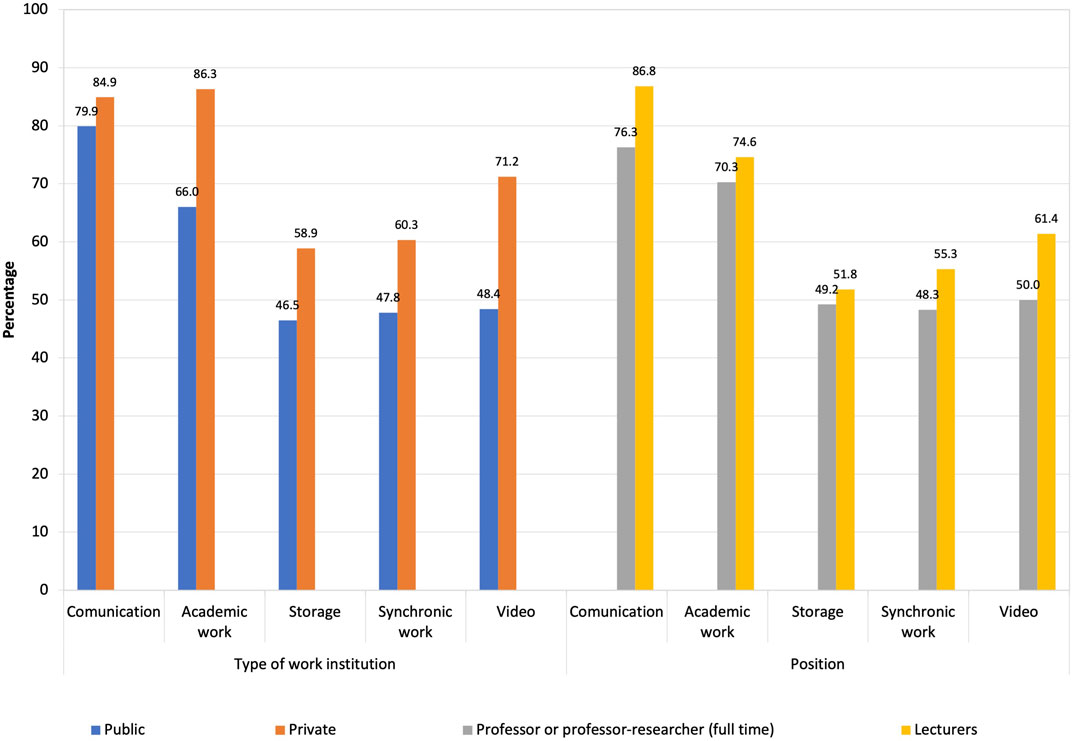
FIGURE 1. Use of technological tools to support their teaching practice previous to the emergency remote teaching model by Type of institution and position.
Technological, Connectivity and Logistical Conditions, Previous to the Emergency Remote Teaching Model Change
We collected information for five indicators of technological conditions, two of internet connectivity, and three related to logistical adaptations for teaching practice. Of the ten indicators identified in seven of them, private universities professors had better conditions than those from public universities. However, the differences between the two types of professors are small and range from 1.5 to 3.5 percentage points.
We observe the most significant variations in infrastructure adaptations. Examples of these included having a desk to develop its teaching activities (with a difference of 10.5 percentage points) and having a quiet and distraction-free space to develop teaching activities at home (that presented the greatest variation, a 17.7 percentage points difference).
The three categories in which professors at public universities had better conditions are having a mobile phone and an electronic tablet for exclusive use and having internet connection at home. In the other hand, full-time teachers show better technological adaptations than lecturers.
In contrast, lecturers presented better conditions concerning logistical endowments presenting more than a 20-percentage points difference for the desk to develop activities as a teacher and a quiet and distraction-free space for teaching activities from home in relation to full-time teachers. A result to highlight is that one quarter of both types of professor declared internet connection problems (Figure 2).
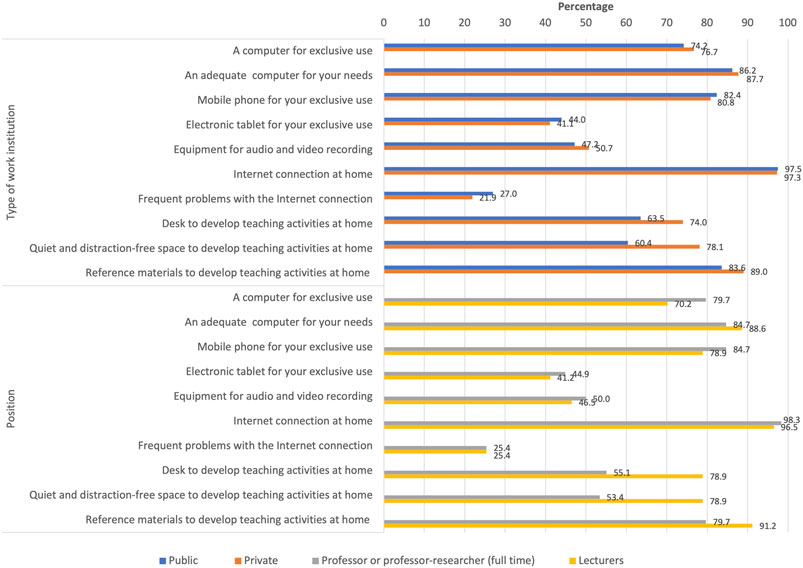
FIGURE 2. Technological, connectivity, and logistical conditions for the teaching practice previous to the emergency remote teaching model, by type of work institution and position.
Use of Digital Technology Tools During Current Academic Work
Concerning the use of technological tools to support their teaching practice, teachers from private institutions showed better conditions than professors at public universities in the five categories of tools defined for this study: communication (93.2%); academic work (91.8%); storage (56.2%); synchronic work (91.8%); video (82.2%). In the case of distinction by type of contract, lecturers presented better conditions of use in four categories of tools: communication (93%), academic work (84.2%), video (76.3%), storage (52.6%), but in the case of synchronic work, full-time teachers had a better condition (90.7%) (Figure 3).
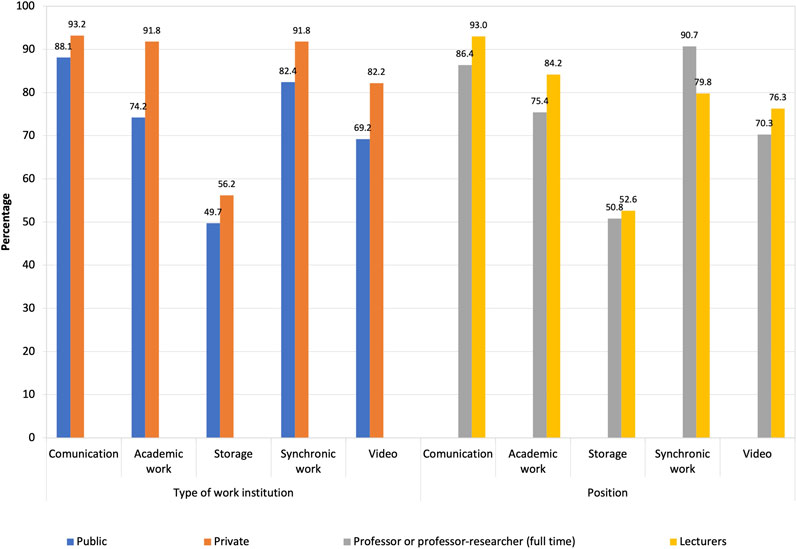
FIGURE 3. Use of technological tools as a current support for their teaching practice by type of work institution and position.
The biggest variations between the use of tools before the emergency and currently is in synchronous work tools and are presented by full-time teachers. They have an increase of 42 percentage points. The second place was in public universities teachers, with a rise of 34 percentage points, followed by teachers from private institutions with 31 percentage points, and in the case of lecturers, the increase was 24.5 percentage points. The slighter variations were in the case of storage tools.
Differences in tool use are less marked when analyzing by position type. The biggest difference in using synchronous work tools are between full time professors and lecturers. The type of tools with the lowest level of difference is communication tools, which may be related to the availability and popularity of such tools. The category of tools that has the greatest difference between teachers by type of institution is academic work tools. We need to remember that this tools should be provided by the institution. However, it stands out that less than half of professors at public universities use that type of tools (Figures 1, 3).
Technological Conditions for the Current Teaching Practice
Concerning the technological conditions for their current teaching practice, public university professors declared that they were in better conditions than private universities professors. Public university professors presented the highest proportion of computer equipment for exclusive use (73.6%), electronic tablet for exclusive use (43.4%), and equipment for audio and video recording (27.7%), exclusive mobile phone (83.6%) and problems with an internet connection (24.79%) show a better level for private universities professors.
Concerning the technology conditions for their current teaching practice, full-time professors report better conditions in exclusive use computers (80.5%), mobile phones (83.9%), and electronic tablet (50%). In contrast, lecturers recorded greater access to audio and video recording equipment (27.2%) and had less frequent internet connection problems (21.9%).
Regarding the technical conditions for their current teaching practice by type of institution, variations range are from less than one percentage point to less than five percentage points. When we analyze by contract type, the variations are greater, having a variation of 11.2 percentage points in the frequency of internet connection problems at home and 16.5 percentage points for availability of computer for exclusive use (Figure 4).
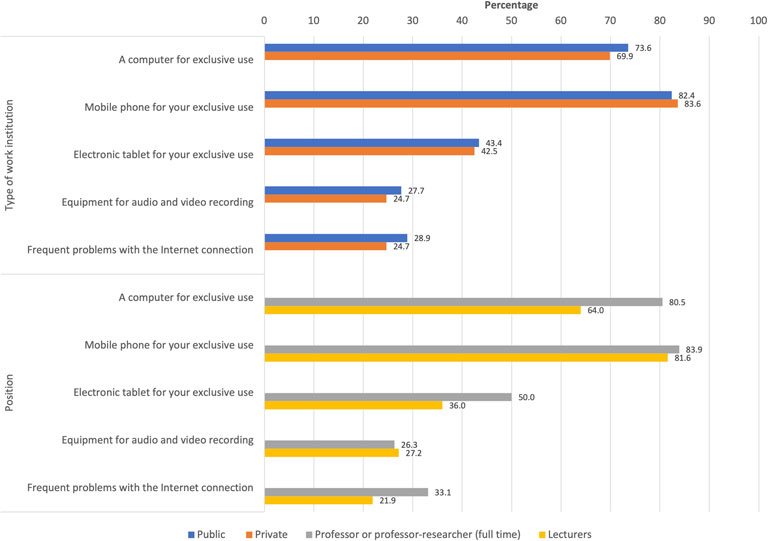
FIGURE 4. Technological adaptations, connectivity in the current teaching practice of teachers by type of work institution and position.
About the technological characteristics declared before the pandemic, there is a greater variation for the four categories of teachers in the provision of audio and video recording equipment. In all four cases, this is a decrease ranging from 19.3 to 26 percentage points for professors; this indicator’s behavior contrasts with the increased use of videos and tools for synchronous work declared by university teachers. We believe this may be because although more audio and video tools are used to have synchronous sessions, they are considered part of communication platforms even when audio and video are being streamed and were previously used to record the session (Figures 2, 4).
Current Logistical Problems in Teaching Practice
The full-time professors and public universities professors declared the greatest proportion of problems concerning current logistical issues. The main difficulty is the distribution of time between teaching and household activities; in this case, participants reported having this problem at 65.3% and 59.7%, respectively. The second most common problem for the four categories of teachers was the extra hours of attention to students, with more than 50% in all of them, reaching almost 6 out of 10 for teachers in private universities. The third problem with the greatest presence is the teaching practice time management and was reported by 47.8% of professors from public universities and 46.6% by full time professors. For the four categories of teachers, the least problem stated was institutional communication with coordinators or managers. Combining these situations may have exposed teachers to a process of physical and emotional breakdown, which could be reflected in their teaching performance (Figure 5).
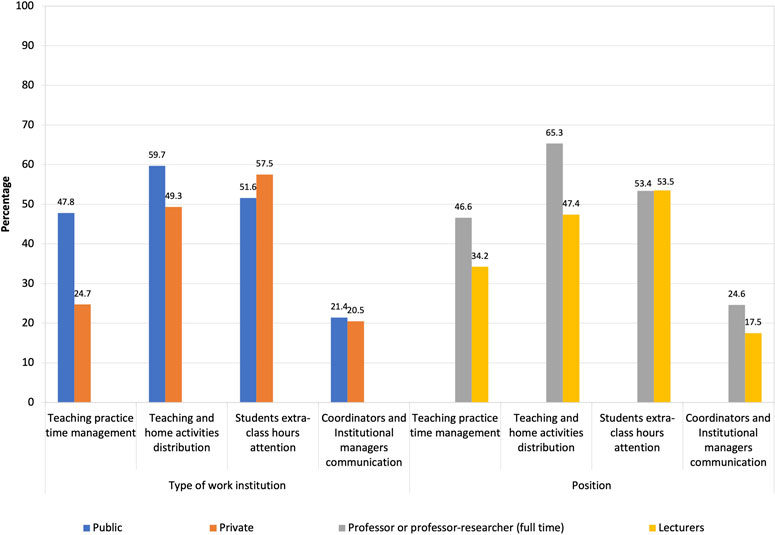
FIGURE 5. Current logistical problems in the teaching practice by type of work institution and position.
Barriers in Teaching Practice
The four categories of teachers consider in a large proportion that working hours are more strenuous than before the online modality, full time professors 79.7%, Public 73.6%, Private 69.9% and lecturers 64.9%. The following most relevant problems are associated with having received less attention from students in 52.1% and 61% of cases in all teacher’s categories, between 53.4% and 59.3% of teachers reported having seen greater difficulties in students in following the directions (Figure 6).
The Economic Impact of Teaching Work From the Teachers'
In general, we observe minimal variations between expenditure increases for six of the eight indicators for each pair of professors’ categories analyzed. Between full time professors and lecturers, the biggest difference in spending was data expenditure for the cell phone and electricity service. Overall the largest increase in payments declared by the four categories of teachers was the Electricity Service. The second expense declared in a more significant proportion by three categories of teachers was the house’s internet service; the third expenditure declared in greater proportion by three categories of teachers was the spending on data for the cellphone (Figure 7).
Discussion
The emergence of COVID-19 represents, to date, one of the most significant health crises in the recent history of humanity; at signs of its rapid spread, national governments around the world began to take steps that sought to contain the rate of dispersal of the disease (UNESCO, 2020b; UNESCO, 2020c). Among the activities that underwent a drastic change in their usual way of developing was education at all levels, moving from an in-person modality to an emergency remote teaching modality (Hodges el al., 2020; Mahdy, 2020; Pragholapati, 2020; Sahu, 2020). Both educational institutions and teachers had very little time to implement the changes necessary to not interrupt the academic cycle (Hodges et al., 2020; UNESCO, 2020b). In Mexico, this change took place a little more smoothly, as it coincided with the Easter holiday period so that the transition could be carried out in a somewhat less hasty way. However, university teachers (like the rest of the teachers at the other educational levels) were not fully prepared to cope with this change. This premise was one of those that gave rise to this study.
Participants in this study are 285 undergraduate, master, or doctoral higher education teachers from public or private institutions in Mexico who taught between January and July 2020. This study is one of the first to be carried out in this regard in the country; we only reference the one presented by UNAM. (Sanchez et al., 2020). The emergence of COVID-19 and its initially unsuspected consequences have had impacts that go beyond the field of public health. The rapidity with which the outbreak spread and the little information about its potential led governments to make strong decisions to try to keep this disease under control. More than eight months into the confinement, little is known about the consequences it has had and will have in the future. In particular, there are many concerns about how student’s academic readiness will be affected, and what other impacts will be in the immediate future. For this reason, this document seeks to contribute information on how teachers faced the transition to emergency remote teaching, as a diagnosis of their ability to respond to challenges of this magnitude. The data presented seek to provide inputs for decision-making that contribute to the search for solutions to emerging problems in the field of university education.
The intention was to have a sample that would represent the structure of the national teaching plant and have a presence of 59% of public university teachers and 41% of private university teachers (Asociación Nacional de Universidades e Instituciones de Educación Superior - ANUIES, 2020); however, we had greater participation of professors from public universities (69%). On the other hand, we tried to have a participation of 70% of lecturers because it was the proportion identified at the national level (OCED, 2019), but we had very balanced participation between the two categories of teachers. Nearly a third of teachers had four or more courses, 38% had four or more groups, and 52% served 60 or more students. More than fifty percent declare to have another job, which is associated with being a lecturer.
In this study, the data captured show that professors from private universities and lecturers, in contrast to their peers, declared a more significant proportion use of technological tools to support teaching practice since before the health emergency (Sanchez et al., 2020). This result seems consistent with the fact that private universities offer a considerable number of courses online, so teachers are more likely to be familiar with these academic work tools. Similarly, there was an increase in the proportion of teachers who used technological tools due to the shift to remote education; mainly, teachers showed more significant use of communication tools. This latest fact clarifies that teachers faced the need to identify new ways to communicate with their students through digital message applications. Despite this availability of digital channels to maintain contact, university teachers indicated that they felt further away from their students, which coincides with the results of a comparative study between teachers and university students in Mexico and Argentina, in which the authors also highlight the existence of better tools for communication as well as an unfavorable impact on teacher-student relationships (Gómez et al., 2020).
In contrast, the data captured in our study suggest that a sector of university teachers had to deal with the shift to the remote teaching model in unfavorable issues of technological and workspace adequacy, which must undoubtedly have represented an additional challenge in adapting to the change in modality. That is, while teachers might be familiar with some technologies that facilitated their work during confinement, they often did not have the right equipment and space in their homes to develop their teaching activities. A similar conclusion was presented in the comparative study with Argentina, where Mexican teachers declared a greater lack of equipment for their teaching work (Gómez et al., 2020).
Another issue that is considered important to highlight has to do with the barriers that teachers perceived during the process of teaching their courses from confinement, considering that their working hours have become more strenuous, that they did not have the tools to optimally manage their time, that they did not find a balance between the time dedicated to teaching and home activities, which is in accordance with the concept of double shift or double presence (Franco et al., 2020), and the identification of schedules to serve students outside the classroom environment, a condition associated with the fact that students paid less attention during class and that they demonstrated greater difficulties in following the teacher’s instructions for carrying out activities, point to an environment of high levels of stress, which could have led the teachers to burnout. These results are consistent with what was found in other studies, related to stress in workers during confinement due to the abovementioned health emergency (Giniger, 2020; Victoria and Curo, 2020).
We want to highlight the lecturers’ case; even though they could have faced more challenges because of their contractual relationship with their higher education employers, the results of this study point out a better response from this group to the emergency remote teaching model. It is important to mention that lecturers could be less involved in university dynamics and have reduced access to the facilities. Based on this premise, lecturers have to cover the requirements for teaching (for example, having a work area in their homes, access to technology and materials) on their own, which allowed them to be better prepared to face the emergency remote teaching conditions. These considerations are supported by the data shown in this article. On the other hand, universities in Mexico should take advantage of the lessons learned from this contingency, through the improvement or the implementation of learning management systems, including instructor training, to be prepared to respond in a more effective way to future emerging conditions.
We acknowledge that this study is missing the institutional perspective regarding the emergency remote teaching model. The study design did not include a review of programs, plans, or any documentation elaborated by the higher education institutions to define guidelines to implement the change of instructional model. This information should be included in future research about this topic to have a better understanding of institutional conditions regarding emergency remote teaching planning, as a framework to be cognizant of how instructor’s and student’s experiences could be defined by the institutional response.
Conclusion
We find that the university-level professors captured in this study had the tools to move their course from a face-to-face modality to emergency remote teaching. Buy they were not homogeneous if we analyzed by type of higher education institution and the type of contract in their workplace. In general, teachers from private institutions presented better conditions for transitioning to the new model without further setbacks. Based on the data obtained, teachers who did not have the equipment or adequate equipment were identified to cope with remote work transition. Similarly, the answers indicate a lack of teachers’ familiarity with various digital tools to facilitate their remote teaching experience. In both cases, it is suggested that universities should implement strategies that enable access to equipment and tools among all their teachers, without making them responsible for covering their cost.
Similarly, since the current situation is unclear about an end date, teachers must receive training to improve their performance under the emergency remote teaching modality and recommendations related to time management and stress management, among other tools to meet the demands of the emerging model.
However, it highlights lecturers, since they reported in more significant proportion to be better prepared for the transition in various areas. Lecturers traditionally do not have adequate workspaces in their universities, so they have had to adapt space in their home to develop their activities outside the classroom, such as preparing classes, reviewing tasks, among others.
It is important to note that in all cases, teachers said they had seen an increase in their expenses related to increased use of electricity and the internet in their homes; this highlights the importance of considering an additional payment as a form of compensation for these higher expenses. Likewise, an important proportion of the teachers stated that their working days became more strenuous, which seems to be linked to the fact that, when working from home, teachers had to face the activities of the home (the so-called double day). The COVID-19 outbreak has undoubtedly represented an enormous challenge in all sectors of country’s life. In the particular case of teachers, the conditions under which they are doing their work should be assessed to identify potential impacts on university-level teachers’ mental health, which may affect their ability to develop their teaching activities.
There is no doubt that more detailed analyses should be done, and for a more extended time on this subject since this is a new topic, as we are still at a stage where we only see the immediate consequences of the change. We must pay attention to the potential implications in the medium and long term. In some areas of Mexico, emergency remote teaching model will be in place at least during the first semester of 2021.
Further research on this topic should consider the impact of the pandemic on socioeconomic conditions of instructors, evaluation of how the emergency remote teaching model has influenced their teaching methods, and how they are dealing with the challenges they faced, one year later. Also, a wider geographical representativity and a bigger sample could allow us to analyze the differences between regions or states. In addition, qualitative data could be collected to gain a better understanding of how the instructors experienced the change of teaching model, and their perceptions and expectations for the future.
Data Availability Statement
The raw data that supports the conclusions of this article will not be available until the authors conclude the analysis they are currently working on for upcoming publications.
Ethics Statement
This project received approval by the ethics committee established 554 by the Mexico Section of the US-Mexico Border Health Commission. A de-identified database was part of the data analysis; the analysis of the data did not include any personal information or any other way to identify the participants.
Author Contributions
RZ-G: lead author, study conception and design, compiled/collected data, data analysis, manuscript writing, critical revision of the manuscript, and final approval of the version being published. JEG-F: co-author, study conception and design, compiled/collected data, data analysis, interpretation of data, manuscript writing, critical revision of the manuscript, and final approval of the version being published. CJG-F: coauthor: revision of the manuscript, final approval of the version being published, JRCG: revision of the manuscript, final approval of the version being published. IP-L: revision of the manuscript, final approval of the version being published.
Conflict of Interest:
The authors declare that the research was conducted in the absence of any commercial or financial relationships that could be construed as a potential conflict of interest.
Acknowledgments
We want to thank all the professors who participated in this study and the colleagues who supported its dissemination.
References
Asociación Nacional de Universidades e Instituciones de Educación Superior – ANUIES (2020). Estadística de Educación Superior, Ciclo escolar 2019-2020. Available at: http://www.anuies.mx/informacion-y-servicios/informacion-estadistica-de-educacion-superior/anuario-estadistico-de-educacion-superior (Accessed November 10, 2020).
Comisión Nacional para la Mejora Continua de la Educación -MEJOREDU (2020). Encuesta sobre experiencias educativas durante el confinamiento por COVID-19. Available at: https://www.gob.mx/mejoredu/articulos/encuesta-sobre-experiencias-educativas-durante-el-periodo-de-confinamiento-por-covid-19 (Accessed November 1, 2020).
Duran, R. (2015). La Educación virtual universitaria como medio para mejorar las competencias genéricas y los aprendizajes a través de buenas prácticas docentes. (doctoral disertation). Universidad Politécnica de Cataluña, Barcelona, España. Available at: https://www.tdx.cat/handle/10803/397710#page=1.
Etikan, I., Alkassim, R., and Abubakar, S. (2016). Comparision of snowball sampling and sequential sampling technique. Biom. Biost. Int. J. 3 (1), 55. doi:10.15406/bbij.2015.03.00055
Fernández, M., Herrera, L., Hernández, D., Nolasco, R., and De La Rosa, R. (2020). Lecciones del Covid-19 para el sistema educativo mexicano. Nexos, distancia por tiempos, blog educación. Available at: https://educacion.nexos.com.mx/?p=2228 (Accesed October 10, 2020).
Giniger, N. (2020). Teletrabajo. Modalidad de trabajo en pandemia. Observatorio Latinoamericano y Caribeno 4 (1), 23–39.
Gómez, G. M., de los Ángeles Miró, M., Stratta, A. E., Mendoza, A. B. M. A. B., and Zingaretti, L. (2020). La educación superior en tiempos de Covid-19: análisis comparativo México-Argentina. Revista de Investigacion en Gestion Industrial, Ambiental, Seguridad y Salud en el Trabajo-GISST 2 (2), 35–60.
Gutiérrez-Santander, P., Morán-Suárez, S., and Sanz-Vázquez, I. (2005). El estrés docente: elaboración de la escala ED-6 para su evaluación. Relieve: Revista Electrónica De Investigación y Evaluación Educativa 11 (1), 47–61. doi:10.7203/relieve.11.1.4196
Hodges, C., Moore, S., Lockee, B., Trust, T., and Bond, A. (2020). The difference between emergency remote teaching and online learning. Available at: https://er.educause.edu/articles/2020/3/the-difference-between-emergency-remote-teaching-and-online-learning (Accessed November 8, 2020).
Instituto Nacional de Estadística y Geografía- INEGI (2015). La encuesta intercensal 2015. principales resultados. Available at: https://www.inegi.org.mx/contenidos/programas/intercensal/2015/doc/eic_2015_presentacion.pdf (Accessed October 18, 2020).
Instituto Nacional de Estadística y Geografía- INEGI (2019). Encuesta nacional sobre disponibilidad y uso de tecnologías de la información en ios hogares (ENDUTIH) 2019. Available at: https://www.inegi.org.mx/contenidos/saladeprensa/boletines/2020/OtrTemEcon/ENDUTIH_2019.pdf (Accessed October 10, 2020).
Mahdy, M. (2020). The impact of COVID-19 pandemic on the academic performance of veterinary medical students. Front. Vet. Sci.. 7. doi:10.3389/fvets.2020.594261
Moreno, M. (2015). “La Educación Superior a Distancia en México. Una propuesta para su análisis histórico,” in La Educación a Distancia en México: Una nueva realidad universitaria, Editors. J. Zubieta, and C. Rama (Mexico city, Mexico: Universidad Nacional Autónoma De México) doi:10.13140/RG.2.1.1440.9360Available at: https://www.ses.unam.mx/curso2016/pdf/18-nov-Zubieta_Educacion_distancia.pdf
Moreno, O., and Cárdenas, M. (2012). Distance education: new modality, new students. The profile of Psychology students in Mexico. Perfiles educativos 34 (136), 118–136. Available at: http://www.scielo.org.mx/scielo.php?script=sci_arttext&pid=S0185-26982012000200008.
Navarrete-Cazales, Z., and Manzanilla-Granados, H. (2017). Outlook on distance learning in Mexico. Revista Latinoamericana De Estudios Educativos 13 (1), 65–82. Available at: https://www.redalyc.org/articulo.oa?id=1341/134152136004.
OECD (2019). Higher education in Mexico labour market relevance and outcomes. Paris, France: OECD PublishingAvailable at: https://www.oecd-ilibrary.org/education/higher-education-in-mexico_9789264309432-en.
Sahu, P. (2020). Closure of universities due to Coronavirus Disease (COVID-19): impact on education and mental health of students and academic staff, Cureus 12. doi:10.7759/cureus.7541
Sánchez, M., Martínez, A., Torres, R., de Agüero, M., Hernández, A., Benavides, M., et al. (2020). Educational challenges during the COVID-19 pandemic: a teachers’ survey at UNAM. Revista Digital Universitaria. Available at: https://www.revista.unam.mx/wp-content/uploads/AOP.pdf.
Secretaría de Educación Pública -SEP (2019). Principales cifras del sistema educativo nacional 2018 – 2019. Dirección General de Planeación, Programación y Estadística Educativa. Available at: https://www.planeacion.sep.gob.mx/Doc/estadistica_e_indicadores/principales_cifras/principales_cifras_2018_2019_bolsillo.pdf (Accessed October 11, 2020).
UNAM (2020). La coordinación de Universidad abierta, innovación educativa y Educación a distancia (CUAIEED). Available at: https://cuaieed.unam.mx/acerca_de#antecedentes (Accessed October 18, 2020).
UNESCO (2020a). COVID-19 y educación superior: de los efectos inmediatos al día después. Available at: http://www.iesalc.unesco.org/wp-content/uploads/2020/05/COVID-19-ES-130520.pdf (Accessed October 18, 2020).
UNESCO (2020b). Education: from disruption to recovery. Available at: https://en.unesco.org/covid19/educationresponse (Accessed November 8, 2020).
UNESCO (2020c). National learning platforms and tools. Available at: https://en.unesco.org/covid19/educationresponse/nationalresponses (Accessed November 8, 2020).
UnADM (2020). Universidad Abierta y a Distancia de México -UnADM. Available at: https://www.unadmexico.mx/nosotros/mision-vision-y-objetivos (Accessed October 18, 2020).
UVEG (2020). Universidad Virtual del Estado de Guanajuato- UVEG. Available at: https://www.uveg.edu.mx/index.php/es/directorio/acerca-de-la-uveg (Accessed October 18, 2020).
Victoria, F. Q., and Curo, G. G. (2020). Impacto psicológico del covid-19 en la docencia de la Educación Básica Regular. Alpha Centauri 1 (2), 30–41. https://org/10.47422/ac.v1i2.10
Keywords: emergency remote teaching, higher education teaching, teaching practice’s experience, COVID-19, Mexico
Citation: Zapata-Garibay R, González-Fagoaga JE, González-Fagoaga CJ, Cauich-García JR and Plascencia-López I (2021) Higher Education Teaching Practices Experience in Mexico, During the Emergency Remote Teaching Implementation due to COVID-19. Front. Educ. 6:628158. doi: 10.3389/feduc.2021.628158
Received: 11 November 2020; Accepted: 01 February 2021;
Published: 12 March 2021.
Edited by:
Leslie Michel Gauna, University of Houston–Clear Lake, United StatesReviewed by:
Helena Montenegro, University of Chile, ChileGayle Curtis, University of Houston, United States
Copyright © 2021 Zapata-Garibay, González-Fagoaga, González-Fagoaga, Cauich-García and Plascencia-López. This is an open-access article distributed under the terms of the Creative Commons Attribution License (CC BY). The use, distribution or reproduction in other forums is permitted, provided the original author(s) and the copyright owner(s) are credited and that the original publication in this journal is cited, in accordance with accepted academic practice. No use, distribution or reproduction is permitted which does not comply with these terms.
*Correspondence: Rogelio Zapata-Garibay, rogeliozapatag@gmail.com
 Rogelio Zapata-Garibay
Rogelio Zapata-Garibay Jesús Eduardo González-Fagoaga
Jesús Eduardo González-Fagoaga Clara Judith González-Fagoaga2
Clara Judith González-Fagoaga2  Ismael Plascencia-López
Ismael Plascencia-López